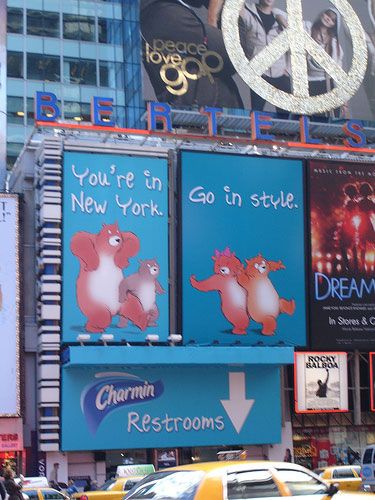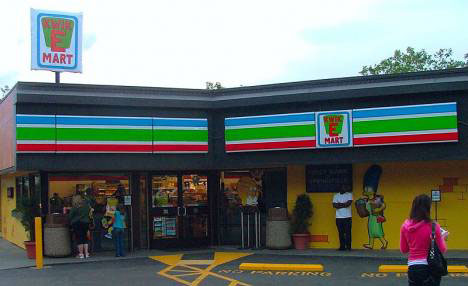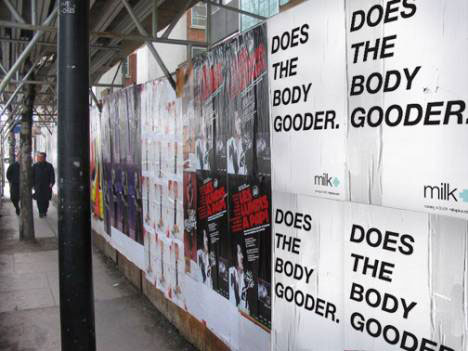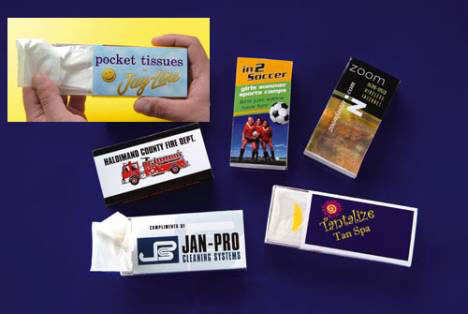Welcome to part six of our eight-part Guide to Guerrilla Marketing. In our journey through the captivating world of guerrilla marketing, we’ve seen some interesting sights. The birth of the concept, its evolution, the big corporations that play the guerrilla game, the viral nature of some campaigns, and gmarketing for social causes have all caught our attention as we stroll along Advertising Street.
Coming up on your left is a peculiar little place. It’s a squat building with the windows blacked out. A security guard stands sentry over the single entrance and regards passers-by suspiciously. This, friends, is where new guerrilla marketing methods are cooked up and shipped out hot and fresh to you, the unwitting consumer. The details of what goes on in there are tightly guarded, but we’ve got a key.
One of the main advantages of guerrilla marketing is that it’s unexpected. It catches us off guard and causes an emotional response: laughter, shock or sadness are great sellers. It’s easy to see why marketers would rather you didn’t know just how they’re using guerrilla marketing to their advantage. If you know their secrets, you may just stop responding.
It probably doesn’t come as a surprise that marketers are a clever bunch. They are well versed in the principles of human psychology that make us want to buy what they’re selling. Anyone who has ever taken a marketing class will probably recognize the psychological principles used to sell us things: reciprocity, authority, consistency/commitment, social proof/acceptance, and scarcity/urgency. And in the methods we’ll explain below, you can find each and every one of those principles. In this installment of our guerrilla marketing series we will take a closer look at some unusually interesting types including ambient marketing, presence marketing, grassroots marketing, wild posting, undercover marketing and astroturfing.

We took a look at viral marketing back in part four of this series. This is a highly visible form of guerrilla marketing these days. A viral campaign can’t be planned or predicted, but it is dearly hoped for by marketers. A successful viral campaign uses existing communication networks (you tell two friends, they each tell two friends, and so on), doesn’t require much in terms of resources, and has the potential to be unstoppable. If you’re giving something away, even better. Remember Gmail invites? They were somewhat difficult to get at first, so everyone wanted one.
Ambient marketing allows a business to create brand recognition without necessarily pushing their products. One excellent example is the Dancing Grass Vans of London. Owned by renegade smoothie makers (and brilliant marketers) Innocent, the vans are covered in real, growing grass and can often be seen around the city making deliveries and drawing stares. Because they serve a real purpose (delivering smoothies), the vans don’t look like advertisements. But do you forget the name of a company with grass-covered vans? Never. Leading up to the release of the Simpsons Movie, 7-11 transformed some of their stores to look just like Kwik-E-Marts, complete with weird Springfield-type products. This ambient marketing campaign was ridiculously effective.
Presence marketing is along the same lines as ambient marketing. It’s about making the business name recognizable and familiar and always there. You know that saying, “out of sight, out of mind?” It goes double for products that don’t maintain a constant presence. This can be achieved through product placements in movies and TV shows, stalls at local festivals and markets, regular Twitter updates, or whatever else makes that product name visible daily. Small businesses and entrepreneurs with modest marketing budgets often find that presence marketing delivers an excellent return for their investment. All they really have to do is be visible.
Grassroots marketing is gaining popularity like – well, like a grass fire. A grassroots campaign can take on many forms, but for the most part it is about winning customers one-by-one rather than on a very large scale. Some grassroots campaigns have elements of presence marketing (like posting on message boards relevant to your business) or viral marketing (like the above user-generated Sony ad). A successful grassroots campaign is all about building relationships and emphasizing the personal connection, not about broadcasting your message and hoping potential customers are listening.
Wild postings may seem old-fashioned, but they are still wildly popular with indie bands and products that want to portray that indie image. Have you ever walked down a city street and seen a wall plastered with multiple copies of a poster for a movie, concert, or alcoholic beverage? Those would be wild postings, and part of their effectiveness lies in the way that they can make us believe we’re witnessing something momentous. Most of us would love to have a poster from the wild posting days of the Beatles, right? So you’d better grab that Smirnoff Ice poster now while you can, right?
Would you rather have your advertising handed to you? Tissue-pack advertising was made popular in Japan, but today it’s spreading to infiltrate the rest of the world. Knowing that advertising fliers were almost never accepted, much less read, Japanese businesses began to hand out pocket packs of tissues with ads on them. This simple but ingenious marketing method works because, well, who would turn down free stuff? Because the giveaway is a useful item, it stays close to the target consumer until it’s been used up. These days, you’d be hard pressed to find pocket packs of tissues in Japanese shops because they are so readily available for free.
Undercover marketing, also known as buzz marketing, is said to be one of the more devious ways of marketing to the masses. Remember the “buy me a drink” girls from part two of this series? These lovely young vixens were being paid to create a buzz around a certain beverage without ever letting you in on their dirty little secret: they were being paid to be so friendly. Undercover marketing/buzz marketing is all about selling something to someone who has no idea they’ve just witnessed a sales pitch.

Astroturfing is widely considered to be the slimiest of all guerrilla marketing practices. It involves creating an artificial buzz about a product or company, and it’s mighty risky in the information age. Postings are created in online forums, singing the praises of a certain product or service – but they aren’t made by the public. They’re made by shills, or people associated with the company who are paid to express a positive opinion. Astroturfing is rampant online in forums and blogs (actually “flogs,” or fake blogs), but you can still see the odd IRL astroturfer wandering department stores, lobbying Congress, and writing letters to newspaper editors.
Alternative marketing is referenced consistently by marketers, but it is by nature challenging to define. It may be best defined as publicity that looks like it is completely removed from the company itself. For example, when Paris Hilton’s Sidekick was hacked, sales of Sidekicks jumped overnight. While T-Mobile probably (maybe?) had nothing to do with that publicity, it was excellent marketing for them. In fact, it has been suggested more than once that the whole event was an orchestrated publicity stunt. Alternative marketing takes a good deal of imagination and a healthy dose of luck to pull off. If the public finds out that they’ve been duped, it will spell disaster for the campaign.

Experiential marketing is increasingly embraced by all types of companies and brands today. It’s becoming easier for us to tune out and ignore advertisements today, so experiential marketing aims to give you an experience rather than send you a one-way message. Experiential marketing lets you interact with the product and associate your immediate emotional responses with that brand. The Charmin Pottypalooza bathrooms at state fairs and the semi-permanent ones (now gone) in New York City are an unprecedented example of effective experiential marketing.
How many of these methods have you seen just this week? With new concepts being rolled out all the time, it’s not always easy to spot when you’ve been targeted.
See More of Our 8-Part Guerrilla Marketing Series:
Guerrilla Marketing 1: History of Guerrilla Marketing
Guerrilla Marketing 2: Origins and Evolution of Guerrilla Marketing
Guerrilla Marketing 3: Major Corporations Go for Guerrilla Marketing
Guerrilla Marketing 4: Guerrilla Marketing versus Viral Marketing
Guerrilla Marketing 5: Guerrilla Marketing for Good Causes
Guerrilla Marketing 6: 10 Types of Guerrilla Marketing
Guerrilla Marketing 7: Is Guerrilla Marketing Right for You?
Guerrilla Marketing 8: The Future of Guerrilla Marketing







